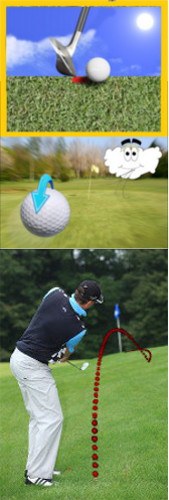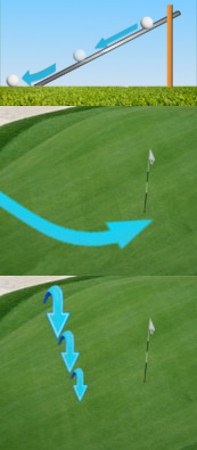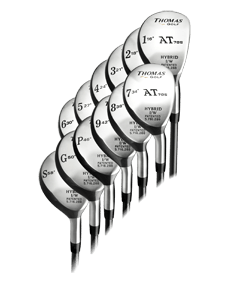
Mid- to high-handicap golfers covet the ability to hit wedge shots that spin backward after landing on the green. But possessing this skill does have its drawbacks (so to speak).
When the greens are especially soft, usually from excess rain or watering, high-spinning shots will sometimes back up 10, 20, even 30 feet or more depending on the green's slope and speed. Occasionally, the ball will end up off the green, perhaps in a hazard. (Witness Kyle Stanley's disastrous approach shot on the 72nd hole of the 2012 Farmers Insurance Open at Torrey Pines.)
There are several ways to combat this problem. First, note that the harder you swing, the more spin you'll impart. That's why you'll sometimes hear PGA Tour commentators refer to a player hitting a wedge shot with “dead arms” in order to decrease spin. Fortunately, there are easier ways to reduce spin without making such a subtle, difficult swing adjustment.
Here are a few tips for high-spin golfers faced with super-soft greens:
- Take more club and swing easier: For example, if the distance calls for a full pitching wedge, hit a soft 9-iron instead. The ball will fly lower with less spin, yet still stop quickly after landing.
- Play the ball forward in your stance: Instead of addressing the ball in the center of your stance, move it a couple of inches forward (toward the left foot, for right-handers). This will create a shallower approach angle and decrease spin. Standing a little wider will enhance the effect.
- Switch to a lower-spin ball: If you know before playing that the greens will be soft, use a ball that spins a little less than your usual model. For instance, if you normally play a Titleist ProV1, grab a sleeve of Titleist NXT Tour balls instead. A little web research of your favorite brand will point you in the right direction.
Too much spin is a good problem to have, but it can be a problem nonetheless. Fortunately, the solutions are pretty simple.

How to Hit Wedges into Soft Greens
For the most part, playing a course with soft greens is going to be a pretty easy task. Certainly, playing when the greens are soft is going to be easier when they are firm. Soft greens accept shots easily, so even your long approaches should come to rest relatively quickly. This means you can be more aggressive, and you will likely set up more birdie chances. Also, getting up and down from tough spots is an easier task, since the ball will stop quickly after it lands when chipping or pitching. In general, you should be quite excited to play a course with soft greens, as there is a good chance that a low score will be waiting for you at the end of the day.
It won't be all smooth sailing, however. There are some challenges that come along with playing shots into soft greens. Specifically, you may find that your wedge shots tend to spin back toward the front of the putting surface after they land. That might look cool to a beginning golfer, but it is actually a point of frustration for the experienced player. You don't want to spin the ball back, because there is really no way to control such a shot. Instead, you ideally want the ball to stop cold as quickly as possible. When you can stop the ball within just a foot or two of where it lands, you will have a great chance to setup some birdies.
In this article, we are going to help you learn how to play quality wedge shots into soft greens. There are a variety of factors at play here, including the mechanics of your swing as well as the planning of the shot. These might seem like pretty easy shots when you are in the middle of a round, but they can quickly go wrong if you aren't careful. Paying attention to even the smallest of details is important here, just as it is important throughout the rest of your game. Cutting corners or ignoring details is a great way to get in trouble on the course.
Even if you play most of your golf in a dry part of the world, it is still helpful to understand how to approach wedge shots when the greens are soft. You never know what conditions you may find when you arrive at the course each day. A course in the middle of the desert could feature soft greens on a day when they watered more than normal for one reason or another. The best thing you can do as a golfer is to be prepared for as many different types of conditions as possible. When you are ready for anything the course may throw your way, you will be able to post consistently good scores on a round-after-round basis.
All of the content below is written from the perspective of a right-handed golfer. If you happen to play left-handed, please take a moment to reverse the directions as necessary.

Using the Right Technique
The technique you are going to use to hit your wedge shots into soft greens is not going to vary greatly from the technique you use for any other conditions. Your swing is your swing, and you shouldn't change it dramatically at any point. You will, however, need to make some modest adjustments in order to give yourself the best chance for success.
The adjustments we have listed below are designed with two specific goals in mind – to bring down the flight of the ball, and to reduce the spin rate of the shot. When playing into soft greens, high wedge shots with a ton of backspin are your enemy. These are the shots that will come zipping back toward the front of the green after they land. By bringing the ball down and lowering the spin rate, you can stop the ball quickly while keeping it in place. This is the kind of shot that will allow you to set up plenty of short birdie putts throughout the round.
To hit the perfect wedge shots for soft greens, please review the tips below.
- Choke down on the grip. When you want to hit the ball lower, the first thing you should do is choke down on the grip of the club. This applies here with your wedges just like it would apply with any other club in your bag. Choking down on the grip is going to shorten your swing, bring down your swing speed, and create less spin at impact. Everything about choking down is perfect for this situation. You should notice that you have more control over the club when choked down, meaning you will hit your target more frequently and you'll experience fewer miss-hits. Even if this is the only adjustment you make when playing into soft greens, you will be going in the right direction.
- Move the ball back in your stance. This is the other obvious adjustment when you need to hit the ball lower. By moving the ball back in your stance, the launch angle for the shot is going to be lower, and the overall trajectory will come down as well. However, it is important to note that it is possible to go too far with this tip. If you force the ball way back in your stance – to the point where it is lined up with your right foot – it is going to become difficult to strike a clean shot. This is a common mistake, and it leads to plenty of poor outcomes. When moving the ball back in your stance, you should only be moving it by just a couple inches. This will be enough to lower the flight without causing you any other difficulties.
- Use a soft grip. Most golfers wouldn't think to pay specific attention to their grip pressure on this kind of shot, but you can quickly improve your results just by playing this shot with soft hands. If you keep your hands tight around the grip of the club, it is likely that you will use too much hand action through impact. Hand action creates spin, and spin is what you are trying to avoid. As you stand over the ball preparing to swing, take a moment to make sure your hands are remaining relaxed and comfortable on the grip. You want to be holding on tight enough to keep the club in your hands from the start of the swing through to the finish, but no tighter.
With the combination of a soft grip, a choked down grip, and the ball behind the middle of your stance slightly, you should have no trouble producing a low wedge shot with a low spin rate. Assuming the greens are soft, and assuming the ball actually lands on the green, this shot should bounce just once or twice before stopping in its tracks. With a little practice, you will get better and better at hitting these shots close to the hole. As your confidence grows, you will start to see every wedge shot into a soft green as an opportunity to make a birdie – and that is a great feeling.

Making a Plan
There is a mental side to each and every shot you hit during a round of golf. While the average golfer pays plenty of attention to his or her technique, far less attention is paid to the thought process that leads up to a shot. If you are willing to work on making a better plan before all of your shots, you can lower your scores without making any physical improvements at all.
For wedge shots into soft greens, there are a few things you need to think about specifically before swinging away. Those key points are listed below.
- Find your landing spot. Every shot you hit should have an intended landing spot. You aren't always going to hit that spot, of course, but picking out very specific target is a good way to focus your mind on the task at hand. This is especially important when hitting a wedge shot, as you can reasonably expect to be accurate with this swing. Once you pick your landing spot, focus all of your mental energy on hitting that spot while blocking out any other distractions.
- Be wary of slopes. If the hole happens to be cut near a significant slope, you will want to provide yourself some margin for error to avoid that spot. Should the ball happen to land on the slope, you might wind up with a ball that spins down the slope even if you took it in on a low trajectory. A slope in the green might not look as intimidating as an actual hazard, but it can potentially be just as costly to your score. Take a look at the overall topography of the green and do your best to avoid areas which are going to cause you trouble.
- Addressing the wind. Even on a short shot like an approach with a wedge, you still need to take the wind into account when thinking through your plan. If the wind is into your face, you will have to hit the shot particularly low to avoid the ball ballooning up into the air. Also, playing the shot downwind is risky because that extra boost could cause your shot to sail beyond the intended target. While there isn't anything you can do to cause the wind to stop blowing, you can plan for it and make sure you hit a shot that isn't going to be too dramatically affected by the breeze.
- Take note of any hazards. In addition to slopes, you also need to keep your ball away from obvious hazards like ponds, sand traps, etc. Wedge approach shots are supposed to be simple, so you don't want to waste strokes by making a mess of this opportunity. It is easy to be too aggressive with a wedge in your hands, but golf is still a game which rewards caution and patience above all else. Identify the hazards which are waiting around the green and factor them in as you finalize your plan for the upcoming swing.
Thinking through each of your wedge shots should teach you the importance of thinking through every single shot you hit on the course. Simply put, you are going to experience better outcomes when you have a plan. This step doesn't take the difficulty out of the game, but it does make it less likely that you will make a silly mistake. Learn how to plan your wedge shots into soft greens and your entire game should take a step forward as a result of your commitment to the mental side of the equation.

Reaching the Back Section of the Green
One of the toughest shots in the game of golf is a wedge approach to a soft green when the hole is cut in the back of the putting surface. This is a difficult shot for a number of reasons. For one thing, you don't really want to swing hard in this situation, but a hard swing might be necessary in order to get the ball all the way back to the hole. It is common to see amateur golfers hit shots which land near the hole in this situation, only to see the ball spin back toward the middle – or even the front – of the green. Few things in golf are as frustrating as seeing your ball land by the hole before spinning away.
Another element which makes this shot difficult is the fact that most greens are sloped from back to front, especially in the rear section of the putting surface. That means you are not only going to need to get the ball all the way back to the target, but you are also going to need to find a way to keep it there. That is no easy task. Even professional golfers hate to see this situation come up, because they know how difficult it is going to be to make a birdie.
So what should you do? The first thing you need to do is prioritize your par above all else. Sure, you would love to make a birdie when you have a wedge in your hands, but you have to respect the situation you are facing. If you get too aggressive in trying to set up a birdie, you could make a mistake which leads to a bogey or worse. At the very least, you want to walk off with a par so you can keep your round on track and play more aggressively when easier hole locations roll around.
Knowing that making a par should be your top priority, there is one mistake you can't make – hitting the ball over the green. If you hit the ball over the green, you are going to be short sided and likely facing a downhill chip shot. This is not a good situation, and you will have to work hard to save that par. The best plan for this type of shot is to take the over-the-green result out of play and go from there.
That means you should be thinking about landing the ball in the middle of the putting surface. Of course, if you hit a normal shot to the middle of a soft green, it is going to stop almost immediately and you will be left with a long putt. To make it possible to reach a position where you will have a shorter putt, the best plan is to bring the ball in even lower than you would have otherwise. This low trajectory is going to lead to a longer, flatter first bounce. Then, thanks to the soft greens, the ball should stop without going much farther. In the end, you are left with a shot that makes its way to the back of the putting surface without ever risking a big mistake.
It is going to take some practice to master this kind of shot, so don't just reach for it during your next round without any preparation. Work on hitting particularly low approach shots by choking down even farther than normal on your wedges. Also, you will want to use more club than you would otherwise, since you are taking so much off the shot. A shot which would normally be played with a sand wedge may now call for a pitching wedge, and a regular pitching wedge shot might need to be dealt with using a nine iron.

Consider the Lie of the Ball
This last section of the article has to do not with what you will find up at the green, but rather with what is going on under and around the golf ball. What kind of lie do you have? Is the ball sitting nicely in the fairway, or is it sitting down in the rough? There are a number of factors related to your lie which can influence how you should approach this shot.
The following points will discuss some of the key elements to watch for regarding the quality of your lie.
- Playing out of the rough can be ideal. This might not be a point you expected us to make, but hitting wedge shots out of the rough into a soft green can be a perfect situation to be aggressive. Since you are in the rough, the ball is not going to have very much backspin – meaning you don't really need to worry about it zipping back after it lands. Also, it is easy to hit the ball straight out of the rough (in most cases), so you should be able to get the ball on line. Don't be surprised if some of your best approach shots come in this specific situation.
- Watch out for an upslope. Hitting your wedge shot off of an upslope into a soft green might be the most difficult situation of all to handle. That upslope is going to make it hard to keep the ball down, and as a result your shot is going to come in from a rather steep angle. On top of that, there will be more spin on the ball than you would like in most cases. Add it up, and you have a recipe for the ball to come spinning back toward the front of the green. You can do your best to mitigate the circumstances by using extra club and swinging soft, but this is always going to be a tough spot to handle.
- Focus on solid contact. If the greens are soft, there is a pretty good chance that the fairways are going to be soft as well. With that in mind, it is important to focus on solid contact when making your swing. Keep your head still, maintain your balance, and keep the club moving all the way through impact. If you let your focus slip, even just a little bit, you may miss-hit the shot and come up short. Miss-hit wedge shots are punished particularly harshly when the ground is soft, so you aren't going to have much margin for error. Fortunately, the standard adjustments you should be making for this kind of shot, such as choking down and moving the ball back in your stance, will make it easier to achieve a solid strike.
Playing a wedge shot into a soft green isn't the easiest thing you will do in golf, but it certainly is a lot easier than many of the other situations you will encounter. By following the advice provided in this article, you should be well on your way toward hitting some of the best approach shots of your golf career. Be sure to practice the techniques we have recommended before you use them on the course. With any luck, you will set up several great birdie opportunities in an upcoming round thanks to your newfound skills in this area. Good luck!






